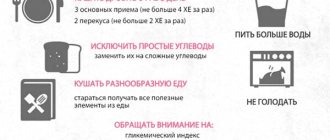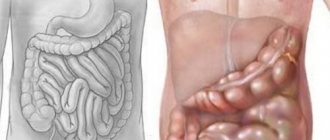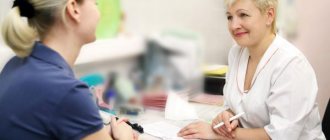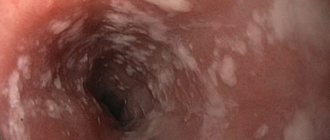Types and stages of the disease
In clinical practice, the following stages of diverticular disease are usually distinguished:
- Diverticulosis is asymptomatic. In half of the cases, the pathology does not have pronounced clinical manifestations for a long period and is discovered accidentally, after contacting a specialist for another reason.
- Diverticulosis is acute. Characteristic signs are spasms of the walls of the sigmoid colon, a high content of pathogenic microflora in the affected area and nearby parts of the intestine, and disturbances in digestive activity.
- Complicated diverticulosis. The extreme stage of the disease, which is characterized by critical states of the patient’s well-being. Requires immediate medical intervention.
Complicated diverticulosis, in turn, is divided into the following categories:
- Diverticulitis of the sigmoid colon. It develops as diverticula are filled with feces, which creates favorable soil for the proliferation of pathogenic bacteria, as a result of which the threat of infection increases;
- Peri-intestinal infiltrate. Occurs when the abdominal cavity is subject to extensive inflammation, and the surface of the diverticulum itself is significantly damaged;
- Intestinal fistula. It is characterized by spontaneous opening of the abscess, affecting neighboring tissues and organs, which entails the formation of external and internal fistulas. This form requires urgent surgical intervention;
- Intraintestinal hemorrhage. Occurs due to damage to the intestinal mucosa through exposure to hardened feces. Vessels are damaged, and significant volumes of blood are lost both during and independently of defecation;
- Diverticulum perforation. If perforation affects the peritoneal area, this threatens the occurrence of peritonitis; if the mesentery of the sigmoid colon is affected, the patient runs the risk of getting retroperitoneal phlegmon.
Peculiarities
Intestinal diverticulosis is characterized by neoplasms in any part of the intestine that are shaped like pouches. The sigmoid colon is often subject to deformation. There is a protrusion of the wall of the formations. Is a congenital or acquired pathology. In its uncomplicated form, diverticulosis shows virtually no signs. Sometimes symptoms appear that may be similar to other diseases of the gastrointestinal tract. Diagnosed during an examination that was carried out for another reason.
The main reasons are:
- Constant constipation.
- Lazy bowel syndrome.
- Low amount of plant fiber in the diet.
- Atherosclerosis of the vascular system.
- Presence of excess weight.
- Development of infections in the intestinal cavity.
- Development of flatulence.
- Lack of physical activity.
A timely visit to a doctor will avoid complications and the disease becoming chronic. The diet is prescribed for diverticulosis of the sigmoid colon.
Symptoms of the disease manifest themselves in problems with defecation, a feeling of nausea and vomiting, and belching.
Complications of the disease are recorded in the form of bleeding, intestinal obstruction, inflammation of diverticula and other pathological conditions.
Causes of diverticulosis of the sigmoid colon
Diverticulosis develops due to a combination of factors that occur in older people. Over time, certain areas of the walls of the sigmoid colon begin to weaken, as a result of which, first, minor protrusions are formed, and then full-fledged diverticula. The main reason for the appearance of areas of intestinal weakening is a violation of innervation.
The aging process predisposes to the appearance of diverticula. As we age, dystrophic changes are observed in the tissues of all organs, including the intestinal muscles. Among other things, older people experience a decrease in the level of nutrients in the body, which predisposes to the appearance of protrusions in the intestines.
Another common cause of diverticula is weakness and underdevelopment of connective tissue. It should be noted that such developmental disorders, as a rule, do not lead to the appearance of diverticula at a young age, but almost always provoke protrusion of sections of the sigmoid colon in the elderly. Underdevelopment and weakness of connective tissue is a congenital defect characterized by a failure in the synthesis of collagen fibers.
In addition, an increased risk of diverticula occurs in older people with signs of incoordination of intestinal motility. The fact is that chronically increased intraintestinal pressure causes stretching of the muscle fibers of the walls of the sigmoid colon and, over time, leads to the appearance of a full-fledged diverticulum.
In some cases, severe spasms of the intestinal walls can provoke the appearance of a sigmoid colon diverticulum. During a spasm, intrawall blood vessels are compressed, which leads to disruption of blood microcirculation. Impaired tissue nutrition irreversibly leads to the appearance of areas of muscle tissue degeneration and stretching of the perivascular spaces.
Improper nutrition also contributes to the development of diverticulosis of the sigmoid colon. Diverticular disease of the colon almost never occurs in people who prefer plant-based foods rich in fiber. At the same time, among people living in developed countries and who prefer to eat soft foods rich in animal fats, the incidence rate is extremely high.
Hereditary predisposition also plays a role in the process of damage to the sigmoid colon by diverticula. Currently, there are no known genes that can be transmitted and lead to weakening of the muscles of the intestinal walls, but, according to statistics, people who have relatives suffering from diverticulosis in old age often experience the appearance of a similar disease.
Disease prevention
As preventive measures we can recommend:
- change your lifestyle to a more active one;
- closely monitor your health and consult a doctor in a timely manner;
- increase the amount of vegetables and fruits in your diet.
Diverticulosis of the sigmoid colon, like most diseases of modern man, is associated with a sedentary lifestyle, the presence of heavy fatty foods in the diet and bad habits.
Therefore, if you do not want to see a doctor with this unpleasant disease in old age, then you should think about it much earlier. Prevention of the disease is useful and pleasant - more vegetables and fruits in the diet, adherence to a diet and exercise while working sedentary.
Symptoms of diverticulosis of the sigmoid colon
In most patients, diverticula of the sigmoid colon do not manifest themselves in any way. A person may not know about his problem for years until a complication arises, or he turns to a proctologist in connection with another pathology. A fifth of patients complain of periodic abdominal pain of the colic type. The pain is blurred or localized in the left iliac region; upon palpation, the abdominal wall is not tense. The pain syndrome can go away on its own, sometimes relief occurs after bowel movement. In addition, there is bloating, constant constipation, which is periodically replaced by diarrhea. All these symptoms fit into the clinical picture of irritable bowel syndrome, which makes diagnosis much more difficult.
Symptoms change and become more pronounced when complications occur. The most common of these is diverticulitis, or inflammation of the diverticula of the sigmoid colon. It occurs due to stagnation of feces in the intestinal lumen and in the diverticulum itself, the action of intestinal flora and increased permeability of the weakened walls of the sigmoid colon. Abdominal pain intensifies, its localization is often unclear. On palpation, there is some tension in the anterior abdominal wall and increased pain in the left iliac region. The patient's temperature rises and symptoms of intoxication appear.
The further course of the disease can lead to the formation of an infiltrate. Inflammation spreads to the mesentery, omentum and surrounding tissues. On palpation, a painful lump with limited mobility is felt in the left lower abdomen. An abscess may form at the site of the infiltration. The patient's condition deteriorates sharply, the temperature rises to high levels, the fever is hectic in nature with large daily fluctuations. On palpation, strong local tension in the abdominal wall and sharp pain are noted.
Perforation or perforation of diverticula of the sigmoid colon is the most severe complication. The process can develop against the background of diverculitis or without its signs. Patients complain of severe pain, weakness, and fever. The consequence of perforation is always peritonitis or retroperitoneal phlegmon (if perforation of the sigmoid colon diverticulum occurs in its mesentery). The patient's condition is severe, weakness, fever are noted, and symptoms of an acute abdomen are observed. If a perforation hole opens into a hollow organ or onto the surface of the skin of the abdomen, a fistula is formed. Most often, fistulas open into the lumen of the small intestine, bladder, and less often into the lumen of the vagina.
Violation of the integrity of the vessels of the intestinal wall leads to open bleeding. It may be the first and only symptom of sigmoid colon diverticula. Blood appears in the stool; it hardly mixes with the feces and does not change its color. Bleeding is rarely profuse, but can be repeated, since lumps of feces constantly injure the intestinal wall. Frequent bleeding ultimately leads to anemia.
Symptoms
The pain disappears after bowel movement.
Diverticulosis may remain without symptoms for a long time until the inflammatory process begins. The most common symptoms are severe cramps in the lower abdomen.
If severe, prolonged pain, nausea and diarrhea develop, these are the first symptoms of the onset of the inflammatory process of diverticulosis of the sigmoid colon.
Many people think that these pains are due to diet, since after a bowel movement the pain disappears and does not appear for a long time.
Even if the disease begins without symptoms, after a while pain and other discomfort will begin. to go to the doctor and start treatment immediately after the first symptoms appear.
Diverticulosis of the sigmoid colon leads to the following negative consequences:
- Bleeding . They appear after inflammatory processes and ulcer formation. There is blood in the stool, which can lead to anemia and other complications.
- Diverticulitis . Feces that are retained in diverticula can cause inflammation, severe pain, and mucus in the stool.
- Fistulas . Diverticula that become inflamed and fester can turn into fistulas, the treatment of which is much more difficult. Fistulas are a kind of canal that forms between hollow organs. In a woman, fistulas can connect to the vagina. Fistulas can also be connected by the stomach or bladder. In this case, surgical intervention is required.
- Perforation of the diverticulum.
- Intestinal obstruction . Diverticula rarely form adhesions in the intestine, leading to intestinal obstruction.
Complications of diverticulosis of the sigmoid colon
In the absence of appropriate treatment, developing diverticula in the sigmoid colon can lead to the following complications:
- Bleeding from the rectum. It occurs due to damage to the vessels surrounding the diverticulum, and is characterized by blood in the stool after defecation. The severity of bleeding varies depending on the size of the damaged vessels;
- Diverticulitis is inflammation of the diverticula of the sigmoid colon. The cause is bacteria that, together with feces, are retained in diverticula. Manifested by abdominal pain, mucus in the stool, increased body temperature;
- Perforation (breakthrough) of a diverticulum, with the release of the contents of the sigmoid colon into the peritoneal cavity and the development of peritonitis (inflammation of the peritoneum).
Laxatives
One of the symptoms of intestinal diverticulum is constipation. Boiled beets are used as a natural laxative. Boiled beets are used as a salad with the addition of olive oil. To loosen stools, decoctions of dried fruits are used.
Treatment of diverticulitis with folk remedies becomes an addition to the main therapy. It is not recommended to treat diverticulosis on your own to avoid exacerbation. A dangerous complication is rupture of the diverticulum.
We recommend: Causes and how to treat fecal incontinence (encopresis)
Diagnosis of diverticulosis of the sigmoid colon
When examining a patient, a specialist pays attention to a number of factors: characteristic complaints, the patient’s age, lifestyle, diet, and tendency to constipation. The doctor examines the patient, using palpation to identify painful areas characteristic of the disease.
A detailed history will help clarify the clinical picture and suspect diverticulosis. To confirm the diagnosis, the patient is prescribed a series of laboratory tests and hardware examinations.
- Colonoscopy. A research method that allows you to assess the condition of the intestines from the inside. The procedure is carried out using a special flexible probe with a video camera at the end, which is inserted into the intestines through the anus. The image from the camera is displayed on the monitor, and the doctor can visually assess the condition of the intestinal walls, the presence of diverticula, and even take a piece of tissue for examination.
- Irrigoscopy. During the examination, an X-ray of the intestine is taken, previously filled with a contrast agent. If diverticula are present in the intestine, the contrast agent will fill them, and these pouch-like protrusions will be clearly visible on the image.
- Laparoscopy. It is both a diagnostic and treatment method. During the examination, the surgeon makes three punctures in the abdominal wall, through which a miniature camera is inserted, allowing you to examine the surface of the intestine and, under magnification, notice the slightest changes on its walls. If necessary, your doctor may remove an uncomplicated diverticulum. The procedure is performed under general anesthesia.
In some difficult cases, the patient may be prescribed a survey radiography of the abdominal organs or visual examination methods such as computed tomography and MRI. A method such as ultrasound in this case is not informative and is not used to clarify the diagnosis.
Treatment of diverticulosis of the sigmoid colon
The choice of treatment methods for diverticulosis of the sigmoid colon is influenced by a number of factors, which the doctor performing the therapy must take into account. The most important among them are age, form of the disease, general health of the patient, tendency to various kinds of complications, lifestyle and nutrition. The early stage of the disease can be treated with conservative methods and means. For patients with complicated and extremely severe forms of this intestinal pathology, surgical intervention is indicated.
Conservative treatment is carried out comprehensively, and the patient is shown:
- products that restore a healthy environment in the intestines;
- special laxatives that contain lactulose;
- antibiotics with a wide spectrum of effects;
- prokinetics that activate intestinal muscle motility;
- antispasmodics, pain relievers and eliminate spasms of intestinal muscles;
- drugs that eliminate diarrhea and bloating;
- some enzymes aimed at improving the quality of digestive activity.
If diverticular disease is in an extremely advanced form, treatment consists of the following therapeutic measures:
- the intestines are unloaded using a siphon enema;
- gastric lavage is performed;
- inflammation is eliminated using fresh frozen plasma;
- infusion therapy is carried out using crystalloid agents.
Surgical intervention should be resorted to in the following cases:
- formation of fistulas in the rectum;
- extreme aggravation with incessant spasms;
- high probability of formation of a malignant tumor of the rectum.
The surgical operation is carried out in two stages. In the first of them, resection is performed, i.e., the affected tissue of the sigmoid colon is removed. At the second stage, an anastomosis is formed, in which parts of the remaining intestinal tissues are fastened. In addition, the abdominal region is drained, after which antibiotics administered intravenously complete the treatment process.
Healing
If the pathology is in the initial stage of development without symptoms, then preventive measures and a diet are prescribed to prevent constipation. Treatment of diverticulosis of the sigmoid colon in this case also includes a set of exercises to eliminate stagnation of feces.
For more serious inflammatory processes, the following medications are prescribed:
- anti-flatulence medications to reduce gas formation - “Smecta”, “Espumizan”;
- enzyme agents to normalize digestive function and reduce the load on the intestinal area;
- laxatives for timely emptying of this organ - Fitomucil, Microlax, Duphalac;
- prokinetics for normalizing digestive motility and providing antibacterial, antidiarrheal and antiemetic effects - “Ganaton”, “Motilak”, “Motilium”;
- antispasmodics and painkillers to relieve spasms and eliminate pain syndromes: “No-shpa”, “Spazmalgon”, “Drotaverine”;
- drugs that restore the natural intestinal microflora: “Linex”, “Bifiform”, “Normobakt”;
- antibiotics - three courses of 5 days each, repeated after 10 days: Amoxiclav, Azithromycin, Sumamed.
If serious complications develop, the patient is sent to hospitalization. With it, antibiotics are administered intravenously, which stops the development of inflammation.
In case of diverticulitis of the sigmoid colon, perforation of the protrusion, the presence of multiple diverticula or peritonitis, surgical intervention is performed, which consists of removing the affected area. After a long recovery period, the patient is prescribed antispasmodics, painkillers and laxatives.
Bleeding in many cases is stopped during diagnosis during angiography by intra-arterial administration of Vasopressin. Sometimes it is stopped with surgery. However, angiographic embolization can lead to intestinal infarction in every fifth patient, so it is not recommended. In most cases (three quarters of patients), bleeding caused by the disease stops spontaneously.
Traditional medicine recipes for the treatment of diverticulosis of the sigmoid colon
Often, folk methods are used to treat diverticulosis, of which the most common and effective are the following:
- Flaxseed or olive oil. Take 1 tablespoon of oil once a day before bed. Helps relieve inflammation and normalize stool during constipation. During the day you can season various salads with this oil.
- Decoction of slippery elm bark. A teaspoon of dry crushed bark is poured into two glasses of boiling water and heated for 20 minutes over low heat. Then the broth should be cooled, strained and taken cold.
- An infusion of a mixture of herbs. Take motherwort herb, stinging nettle, dill and rose hips, and chamomile flowers in equal proportions. A tablespoon of this mixture should be placed in a thermos, pour a glass of warm (not hot!) water and leave for 1.5 hours. Then you need to strain the infusion and drink 0.5 cups in the morning and evening. The course of treatment is a month.
Treatment
Diverticulosis is a disease of one of the organs of the gastrointestinal tract, so treatment is carried out by a gastroenterologist. If complications develop, you will need the help of a surgeon, and for diagnosis, an endoscopist.
The uncomplicated form of latent diverticulosis is corrected by a diet that necessarily includes wheat bran in the amount of 5 tablespoons daily. Foods that cause bloating should be avoided:
- legumes;
- cabbage;
- grapes, radishes;
- sunflower seeds;
- nuts.
Drug therapy
For inflammation, medications are used along with diet:
- antispasmodics to relax smooth muscles and relieve pain (Spazmalgon, No-Shpa, Drotaverine);
- enzymes to improve digestion and eliminate bloating (Mezim, Pancreatin, Creon);
- to restore microflora and populate the intestines with beneficial bacteria (Linex, Bifidumbacterin);
- to eliminate prolonged diarrhea (Loperamide, Sulgin) and constipation (Duphalac, Normaze, Mucofalk, Microlax).
The doctor will indicate the dosage and duration of taking the medications. Once the pain, cramping and bloating have stopped, you should not take medications, as they all have side effects and are toxic to the liver.
Complicated diverticulosis is treated with antibiotics (Ciprofloxacin, Amoxicillin) and a diet that includes liquid, pureed food.
In approximately 80% of patients, treatment is effective without surgery.
The Merck Manual
Guide to Medicine. Diagnosis and treatment. Litterra, 18th edition, 2011, p. 215.
Surgery
Indications for surgery are:
- severe diverticulitis with perforation, bleeding and peritonitis;
- fistula formation;
- suspicion of malignant degeneration;
- numerous exacerbations.
Usually a subtotal colectomy is performed - removal of the affected part of the intestine and subsequent connection of the remaining ends. The operation is performed under general anesthesia in an open or laparoscopic manner.
The abdominal method is more traumatic, since the surgeon makes a long incision (25 cm) in the anterior abdominal wall. The area to be resected is separated from the rest of the organs, and its blood supply is cut off. The doctor removes the segment, and if there is no abscess or perforation, an anastomosis (connection) of the ends of the healthy sections is performed.
In case of severe purulent inflammation and bleeding, a colostomy is formed (removal of the final segment of the colon). After the infiltration subsides, the intestines are restored. At the end of the operation, the surgeon rinses the cavity, sutures the incision and inserts tubes into the peritoneum for drainage.
During laparoscopy, through 2 or 3 punctures in the abdomen, doctors introduce special instruments and an optical device with a camera that broadcasts the progress of the manipulations on large screens in the operating room. To improve visibility, the peritoneum is filled with carbon dioxide. Surgeons remove part of the intestine with diverticula and choose the type of anastomosis.
During laparoscopy, surgeons insert instruments into the abdominal cavity through several punctures.
A subtotal colectomy lasts on average three hours. The patient is then transferred to intensive care. After awakening from anesthesia, he is placed in the surgical ward.
Liquid food is allowed to be taken on the day of resection. You should not lie down for a long time to avoid thromboembolism and pneumonia. The patient remains in the hospital for 10 days. Full recovery takes one and a half months. During this period, heavy physical activity is not recommended.
Diet for diverticulosis
In uncomplicated disease, outside periods of exacerbation, the principle of nutrition is to consume foods rich in fiber. However, the transition to a new diet must be carried out gradually. You need to drink at least 1.5 liters of liquid. This volume does not include soup, tea and other drinks. The most useful liquid for the body is water. You should eat 5-6 times a day in small portions.
Permitted for use:
- bran;
- whole grains and dairy products;
- products made from wholemeal flour;
- fruits and vegetables in raw, dried and baked form;
- lean meat and fish.
Photo gallery: permitted products for sigma diverticulosis
Kefir, sour cream, fermented baked milk and cheese restore intestinal microflora
Bran is the main source of fiber
Fruits and vegetables contain plenty of fluids and dietary fiber
Whole grain porridge is rich in fiber
Wholemeal bread cleanses the intestines well
Hot meals with soups and purees are a must for patients with diverticula. It is preferable to boil and stew food rather than fry it, and remove the skin and seeds before cooking.
You should not eat foods that cause constipation and flatulence, as they increase the pressure in the intestinal lumen.
Should be excluded:
- berries with small seeds (strawberries, raspberries, grapes);
- seeds and nuts;
- caffeinated drinks;
- chocolate;
- spices;
- alcohol;
- canned and pickled foods;
- sausages;
- baked goods made from refined flour.
Photo gallery: prohibited products
Small strawberry seeds get into diverticula
Small particles of nuts can get stuck in diverticula, causing inflammation
Tea and coffee sharply increase intestinal tone
Sweet baked goods made from refined flour do not contain fiber
In case of complications of diverticulosis, the patient can eat only liquid food without fiber until the main manifestations of the inflammatory process subside. The attending physician's recommendations regarding nutrition must be strictly followed to avoid exacerbations.
Physical activity for diverticulosis
A sedentary lifestyle negatively affects all systems of the body, including slowing intestinal motility and deteriorating blood supply. Diverticula are not a contraindication for exercise. The main thing is to dose the load correctly.
For uncomplicated forms of the disease, it is recommended:
- walking at an average pace several times a week;
- swimming in the pool and open water;
- tennis;
- gymnastics without involving the lower abdominal muscles.
Breathing exercises do not increase pressure in the intestine, but effectively stimulate its motility. You need to perform the complex an hour and a half after eating. Examples of exercises:
- Lie down on the floor. Place your palms on your lower abdominals. Inhale and inflate your stomach, while exhaling, pull it in. Repeat 10 times.
- As you inhale, sharply draw in your abdominal muscles and hold in this position for 5 seconds. As you exhale, slowly relax. Repeat 5 times.
Retracting and relaxing the abdominal muscles improves blood circulation
After the breathing exercises, you can proceed to the main complex:
- Lie on your stomach on an exercise ball (large ball) and rock back and forth for 6 seconds. Repeat 2 more times.
- Starting position: lying on your back. Bend your legs at the knees, press your feet to the floor. Retract your sphincter muscles and hold for 7 seconds. Relax and perform the movement 4 more times.
- Stand up straight. Place your hands on your belt. Rotate your pelvis along and counterclockwise 10 times.
To work the muscles of the lower back and abdomen, you need to describe a full circle with your pelvis
- Start walking, raising your knees high. Walk for 2 minutes.
Raising the knee engages the abdominal muscles without putting undue pressure on the intestines
You cannot do:
- struggle;
- team sports;
- weightlifting and athletics;
- exercises for the abdominal muscles.
Folk remedies
Consultation with a doctor is necessary before using decoctions and infusions. During the period of calm diverticulosis, you can take oatmeal jelly. It prevents constipation, tones intestinal motility, and eliminates bloating. It is recommended to use it in the morning.
To obtain a healing drink, pour 1 cup of oatmeal with 3 cups of cold boiled water, stir and add a crust of rye bread to the mixture. Cover and put in a warm place for 2 days. Strain the resulting fermented solution through a colander or cheesecloth. Place the remaining flakes in the container in a blender and grind until liquid. This starter should be stored in the refrigerator and used to make jelly.
Kissel made from oat flakes gently envelops the intestines, prevents flatulence and constipation
An easy-to-follow recipe for elderberry infusion: one tablespoon of berries is brewed with a glass of boiling water. After cooling, the drink is drunk instead of tea.
To soften stool, you can grind a handful of sprouted wheat grains and mix them with two rolled green apples. Take 1 tablespoon of the mixture 2 times a day.
Dietary nutrition for diverticulosis of the sigmoid colon
It is impossible to completely get rid of existing diverticula.
But each patient has the opportunity to minimize the likelihood of developing an inflammatory process around them.
To do this, there is no way to do without establishing the correct nutrition process - diet.
This needs to be taken extremely seriously.
It is better to entrust the selection of the right diet to a gastroenterologist.
After a detailed examination, he will check the following indicators:
- The patient's intestinal condition;
- Level of muscle tone;
- Degree of development and number of diverticula;
- The presence and magnitude of the inflammatory process;
- Study of the patient's intestinal microflora
To do this, the patient undergoes a series of special examinations. Based on the research data, the specialist makes the final decision.
The selected diet must fall within certain rules:
- You need to eat often, but in small portions;
- All products must be well chopped. This is necessary so that all food is well coated with digestive enzymes, without raising intestinal pressure;
- The basis of the diet should consist of soups - purees or milk porridges;
- The diet must include a large number of foods that contain a large amount of fiber (fruits, bran, berries, vegetables, etc.);
- The patient should take plenty of fluids between meals. Ideally, these should be herbal decoctions, jelly, compotes;
- If a patient often experiences constipation, it is better not to abuse laxatives, but to drink laxative herbal decoctions: rose hips, prunes, etc.;
- Eliminate from the diet alcoholic drinks, cigarettes, spicy and smoked, sour and salty foods, as well as foods that contain caffeine;
- It is better to replace baked goods made from white bread with those containing bran;
- Avoid sweets and replace them with berries or bananas;
- Instead of apple juice, it is better to eat a raw apple with peel;
- Eat as many baked vegetables and fruits as possible without peeling them;
- Eat bran with kefir or milk;
- Eat vegetarian soups – purees, which include barley groats – once a day;
- It is better to replace beef with beans.
Specialist nutritionists and gastroenterologists recommend that when choosing a diet for patients who have developed diverticula of the sigmoid colon, treatment and diet should not include foods (berries, fruits) that contain seeds. Under no circumstances should you eat strawberries or grapes, nuts or raspberries.
Prevention of diverticulosis of the sigmoid colon
The most important condition for the prevention of this disease is normal intestinal motility, that is, the absence of constipation.
To maintain regular bowel movements you need to:
- perform physical exercises aimed at the abdominal muscles;
- eat enough fiber. The norm recommended by American nutritionists is 20-35 g of fiber. This is exactly what every person should strive to consume. Fiber-rich foods: whole grain bread, berries, vegetables, fruits, brown rice, bran, beans and peas. Thanks to such food, you can prevent constipation and improve your health, lower blood pressure, reduce cholesterol in the blood and the likelihood of developing certain types of intestinal disorders;
- drink enough fluids. If there are no contraindications, the daily norm is at least 8 glasses of water;
- get proper rest and sleep.










